
Lace is a delicate fabric made of yarn or thread in an open weblike pattern, made by machine or by hand. Generally, lace is divided into two main categories, needlelace and bobbin lace, although there are other types of lace, such as knitted or crocheted lace. Other laces such as these are considered as a category of their specific craft. Knitted lace, therefore, is an example of knitting. This article considers both needle lace and bobbin lace.

Bobbin lace is a lace textile made by braiding and twisting lengths of thread, which are wound on bobbins to manage them. As the work progresses, the weaving is held in place with pins set in a lace pillow, the placement of the pins usually determined by a pattern or pricking pinned on the pillow.

A bobbin or spool is a spindle or cylinder, with or without flanges, on which yarn, thread, wire, tape or film is wound. Bobbins are typically found in industrial textile machinery, as well as in sewing machines, fishing reels, tape measures, film rolls, cassette tapes, within electronic and electrical equipment, and for various other applications.
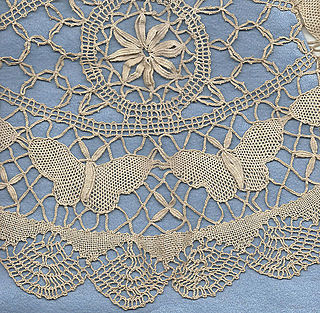
Guipure lace is a type of bobbin lace. It connects the motifs with bars or plaits rather than net or mesh.

Tønder lace is a point-ground type of handmade bobbin lace identified with the Tønder region of Denmark since about 1850, although lace of many types has been made there since as early as 1650. The term is also used more broadly, to refer to any bobbin lace made in Denmark.

Freehand lace is bobbin lace worked directly on the fabric of the lace pillow without using a pricked pattern. Very few pins are needed
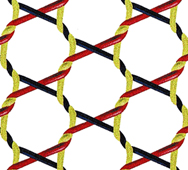
Bobbinet tulle or genuine tulle is a specific type of tulle which has been made in the United Kingdom since the invention of the bobbinet machine. John Heathcoat coined the term "bobbin net", or bobbinet as it is spelled today, to distinguish this machine-made tulle from the handmade "pillow lace", produced using a lace pillow to create bobbin lace. Machines based on his original designs are still in operation today producing fabrics in Perry Street, Chard, Somerset, UK.

Brussels lace is a type of pillow lace that originated in and around Brussels. The term "Brussels lace" has been broadly used for any lace from Brussels; however, strictly interpreted, the term refers to bobbin lace, in which the pattern is made first, and the ground, or réseau added, also using bobbin lace. Brussels lace is not to be confused with Brussels point, which is a type of needle lace, though sometimes also called "Brussels lace".
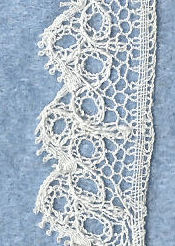
Bucks point is a bobbin lace from the South East of England. "Bucks" is short for Buckinghamshire, which was the main centre of production. The lace was also made in the nearby counties of Bedfordshire and Northamptonshire. Bucks point is very similar to the French Lille lace, and thus is often called English Lille. It is also similar to Mechlin lace and Chantilly lace.

Binche lace is a type of bobbin lace that originated in the town of Binche, Belgium. It is continuous, meaning it is made all at once, in one piece. It is generally made in strips 2 inches (5 cm) wide. Though typically it has no cordonnet outlining the design against the ground, occasional pieces are made with a very fine one, about the same thickness as the thread used in the pattern. The pattern in Binche lace is very detailed, with animal scenes and figures.

Battenberg lace is a type of tape lace. It is of American origin, designed and first made by Sara Hadley of New York. This American lace was named either in honor of the wedding of Princess Beatrice, Queen Victoria's youngest daughter, to Prince Henry of Battenberg, or from the widowed Princess Beatrice. It is made using bobbins and needles, or just needles alone.The original Battenberg lace used just one stitich: buttonhole picot. Other stitches that were later used include flat wheel and rings or "buttons).

Cluny lace is a bobbin lace style, worked as a continuous piece. It is a heavy plaited lace of geometric design, often with radiating thin, pointed wheatears. It is a guipure style of lace.

Tape lace is made with a straight tape which is bent into the shape required and sewn into position. Various needle lace fillings may be used to fill the gaps. The tape is usually machine made. This type of lace is also known as mixed tape lace, or mixed lace, as it uses more than one technique: one in making the tape, and a different technique for the fillings and joins.

Part lace or sectional lace is a way of making bobbin lace. It characterises various styles, such as Honiton lace or Brussels lace.
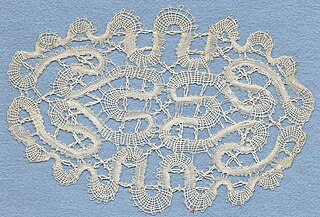
Bobbin tape lace is bobbin lace where the design is formed of one or more tapes curved so they make an attractive pattern. The tapes are made at the same time as the rest of the lace, and are joined to each other, or themselves, using a crochet hook.
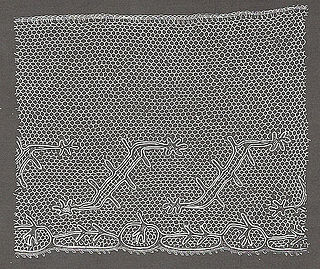
Lille lace was a type of bobbin lace that was made at Lille, also known as Rijsel. It was a lightweight lace popular in the eighteenth century in both black and white. It lacked the rich designs of Valenciennes lace. Its quality declined after the French Revolution, and by 1800 it was worn only by 'the most ordinary women'. In the first half of the nineteenth century the sketch-line designs, made only of gimp, were enclosed by a cloudy fond simple, relieved only by a scattering of tiny dots. After the French Revolution of 1848, little was made commercially.

Mesh grounded lace is a continuous bobbin lace also known as straight lace. Continuous bobbin lace is made in one piece on a lace pillow. The threads of the ground enter motifs, then leave to join the ground again further down the process, all made in one go. This is different from part lace, where the motifs are created separately, then joined together afterwards.

Idrija lace is a bobbin tape lace. The tape is made with bobbins at the same time as the rest of the lace, curving back on itself, and joined using a crochet hook.
Schneeberg lace is a bobbin tape lace. The tape is made with bobbins at the same time as the rest of the lace, curving back on itself, and joined using a crochet hook. This type of lace is developed about 1910 in Schneeberg.

Rosaline lace is a late 17th-century Venetian needle lace, and a late 19th-century bobbin part lace imitation. A Brussels variant with needle lace pearls is called Rosaline Perlée. The variant made in Bruges lacked the pearls.



























